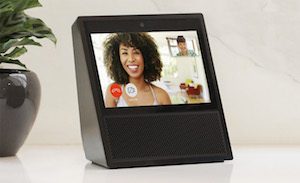 The first reviews of the Amazon Echo Show are out, and most seem positive. When Echo launched back in 2015, Amazon boldly introduced a “voice-only” interface for its devices. At the time, the original Echo was greeted with a mix of confusion and enthusiasm. People weren’t quite sure what to do with a smart speaker, or if they even needed one. But early adopters were soon openly giddy about Alexa.
The first reviews of the Amazon Echo Show are out, and most seem positive. When Echo launched back in 2015, Amazon boldly introduced a “voice-only” interface for its devices. At the time, the original Echo was greeted with a mix of confusion and enthusiasm. People weren’t quite sure what to do with a smart speaker, or if they even needed one. But early adopters were soon openly giddy about Alexa.
Of all the companies in the world, Amazon was arguably the best positioned to kick off the “voice-first” revolution. As one of the first places North American shoppers go to buy pretty much anything, Amazon could push their smart speaker to a huge audience of purchase-ready consumers. They could also enable Alexa to make purchases from the Amazon platform, something the vast majority of Echo buyers were doing already.
Amazon further locked in the platform’s success by inviting anyone to tap into the power of the Alexa Voice Service and by opening the platform to third-party developers. The Alexa team even offered an amazing amount of handholding to anyone keen on figuring out how to make voice-first applications work.
But just as companies and third-party developers had about wrapped their heads around building successful voice-only experiences, Amazon has decided to throw us a curveball. The Echo Show adds a small touch screen to the once voice-only platform. Now what?
We may be standing at a crossroads. It seems that brands and developers are going to have to make a choice. Which path will they go down?
- Stick with voice-only conversational apps
- Proceed down the path that incorporates a screen with visuals into voice apps
- Hedge their bets and do both voice-only and “voice with screen” apps
Adding visuals to an app or skill that was created as a voice-only experience isn’t easy. It’s not as if a brand can just plug its existing mobile app into a voice assistant platform. The entire user interaction has to be re-evaluated. If you start with a voice-only skill, the question brands need to ask is: what visuals will assist the customer in completing their intent? What will the user want to see at this point? Will the visuals be confusing? Will it be easier for the customer to use the touch screen at this point in the interaction, or will it be better for them to use their voice?
Companies that choose to stick with voice only experiences may soon find themselves left behind. Will talking robots without screens be able to compete with conversational robots that not only understand and talk to us, but that show us pictures and video too? Would people want a Pepper robot that didn’t have a screen? Nobody knows the answer at this point.
So, what does the Amazon Echo Show mean for the future of the conversational interface? At first glance, the Echo Show seems to mean that (once again) the rules have changed and all of us are going to have to start working even harder just to keep pace.
Categories: Conversational Intelligence, Intelligent Assistants, Articles

 Beyond the Basics: How AI Is Transforming B2B Sales at TP
Beyond the Basics: How AI Is Transforming B2B Sales at TP  Five9 Launches Agentic CX: Toward AI Agents That Reason and Act
Five9 Launches Agentic CX: Toward AI Agents That Reason and Act  2025 Conversational AI Intelliview: Decision-Makers Guide to Self-Service & Enterprise Intelligent Assistants
2025 Conversational AI Intelliview: Decision-Makers Guide to Self-Service & Enterprise Intelligent Assistants  Talk to the Web: How NLWeb Opens Conversational Access to Site Content
Talk to the Web: How NLWeb Opens Conversational Access to Site Content